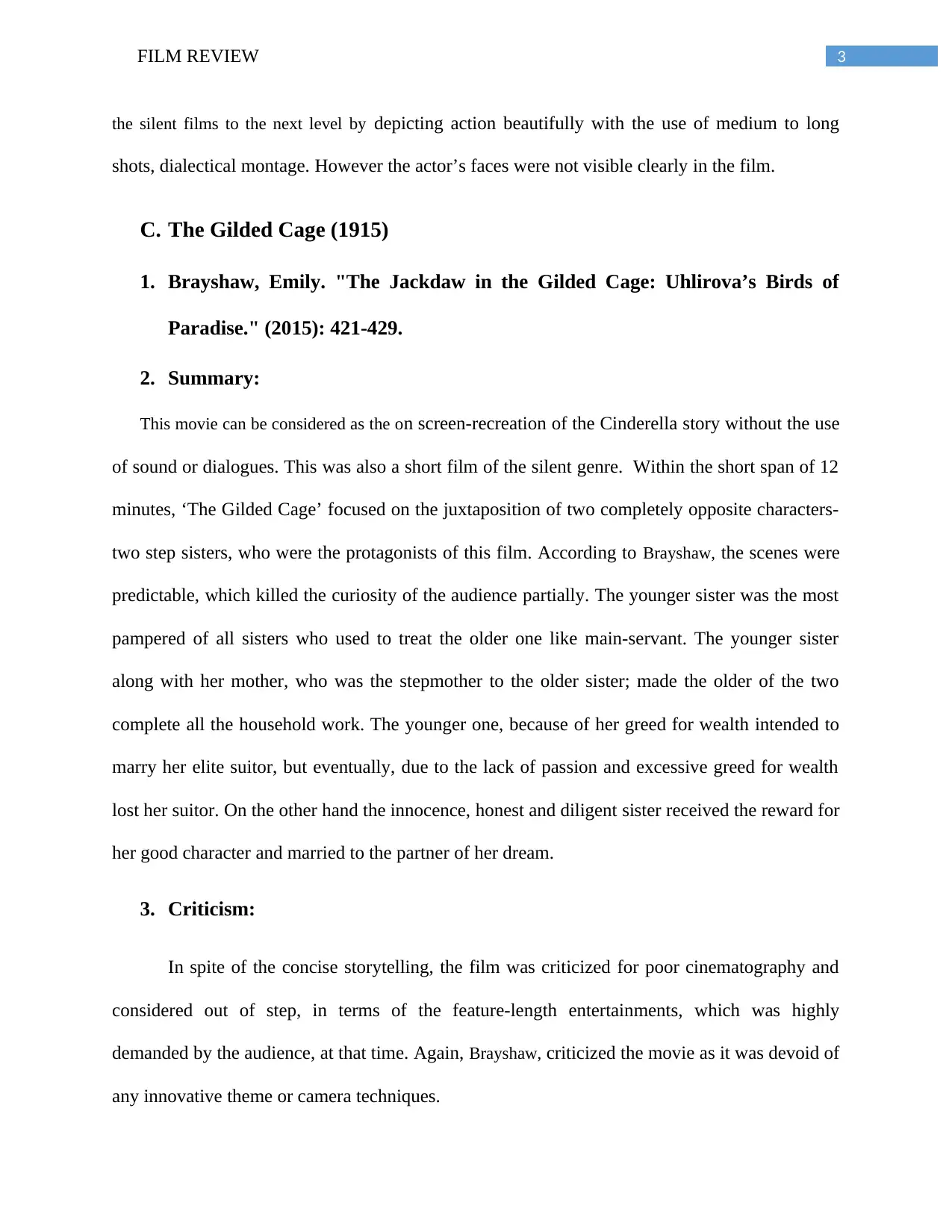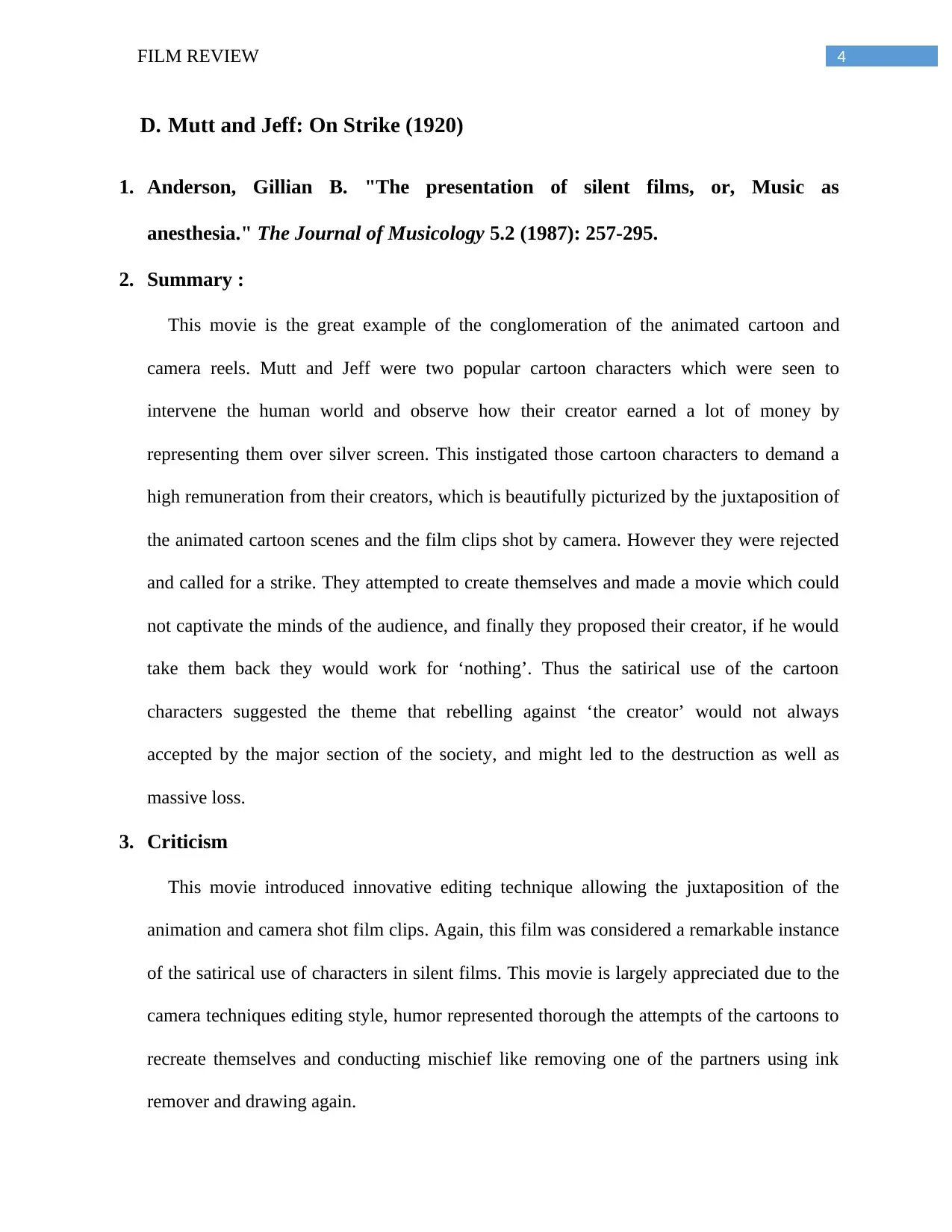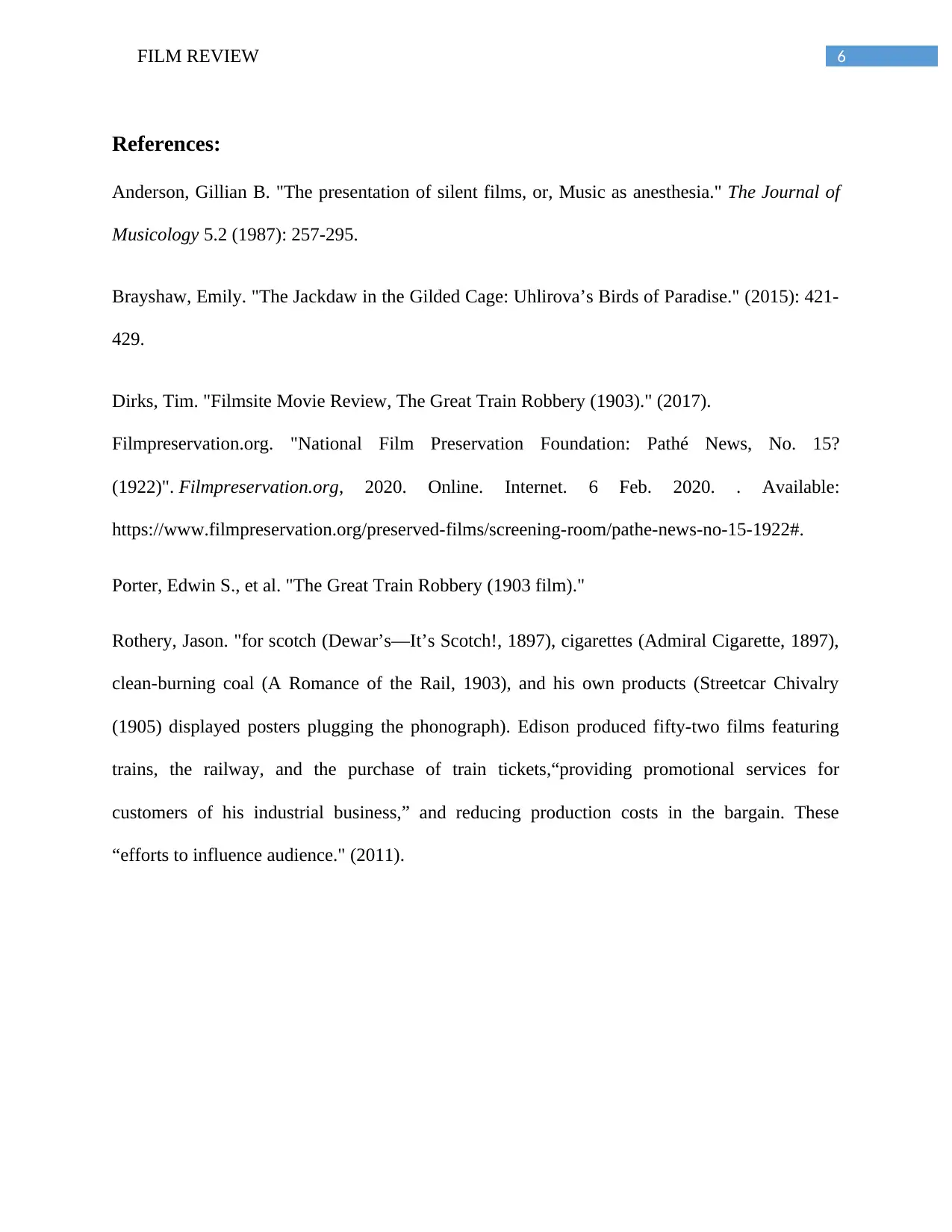Film Review Techniques And Assesment Report
VerifiedAdded on 2022/08/15
|7
|1677
|19
AI Summary
Contribute Materials
Your contribution can guide someone’s learning journey. Share your
documents today.

Running head: FILM REVIEW
FILM REVIEW
Name of the Student
Name of the University
Author Note
FILM REVIEW
Name of the Student
Name of the University
Author Note
Secure Best Marks with AI Grader
Need help grading? Try our AI Grader for instant feedback on your assignments.

1FILM REVIEW
A. Admiral Cigarette (1897)
1. Rothery, Jason. "for scotch (Dewar’s—It’s Scotch!, 1897), cigarettes
(Admiral Cigarette, 1897), clean-burning coal (A Romance of the Rail, 1903),
and his own products (Streetcar Chivalry (1905) displayed posters plugging
the phonograph). Edison produced fifty-two films featuring trains, the
railway, and the purchase of train tickets,“providing promotional services for
customers of his industrial business,” and reducing production costs in the
bargain. These “efforts to influence audience." (2011).
2. Summary:
This is an ad film. This film was the first commercial film to promote a brand
producing cigarettes-“Admiral Cigarettes”. According to Rothery, This film generates a
specific propaganda that smoking cigarette is the habit of several classes of the society.
Rothery considered that the ad film fulfilled its purpose adequately to portray the
growing popularity of cigarette among the broad cross section of 18th century America.
This reflected in the beginning of the film, as the film starts with the animated
conversation among four men representing four distinct classes or the broad cross section
of America in the 18th century. According to Rothery the costumes used in this ad film
provides evidences that the characters were from distinct classes. One of them is dressed
up like Red Indian. Again, one of them has been dressed in trousers with Stars-and-
Stripes printing. Another two have worn suit and long army coats respectively.
3. Criticism:
A. Admiral Cigarette (1897)
1. Rothery, Jason. "for scotch (Dewar’s—It’s Scotch!, 1897), cigarettes
(Admiral Cigarette, 1897), clean-burning coal (A Romance of the Rail, 1903),
and his own products (Streetcar Chivalry (1905) displayed posters plugging
the phonograph). Edison produced fifty-two films featuring trains, the
railway, and the purchase of train tickets,“providing promotional services for
customers of his industrial business,” and reducing production costs in the
bargain. These “efforts to influence audience." (2011).
2. Summary:
This is an ad film. This film was the first commercial film to promote a brand
producing cigarettes-“Admiral Cigarettes”. According to Rothery, This film generates a
specific propaganda that smoking cigarette is the habit of several classes of the society.
Rothery considered that the ad film fulfilled its purpose adequately to portray the
growing popularity of cigarette among the broad cross section of 18th century America.
This reflected in the beginning of the film, as the film starts with the animated
conversation among four men representing four distinct classes or the broad cross section
of America in the 18th century. According to Rothery the costumes used in this ad film
provides evidences that the characters were from distinct classes. One of them is dressed
up like Red Indian. Again, one of them has been dressed in trousers with Stars-and-
Stripes printing. Another two have worn suit and long army coats respectively.
3. Criticism:

2FILM REVIEW
Rothery consider that, the involvement into a discussion, in front of a
billboard-“Admiral Cigarettes”, again, explosion of the giant box containing ‘Admiral
Cigarettes’ reflected monotony created, in order to fulfill the purpose of promoting the
brand of cigarettes. This scene is followed by the scene of cigarettes distribution by a
lady emerged through the explosion and logicless hanging of the banner “We all smoke”,
as it can be observed through the actions of the characters that they all smoke. This film
was also criticized for not highlighting why people would choose to smoke.
B. The Great Train Robbery (1903)
1. Porter, Edwin S., et al. "The Great Train Robbery (1903 film)."
2. Summary:
It is a silent short film. The proficiency of the director as well as photographer
Edwin S. Porter reflected vividly as the film depicted a train robbery beautifully, within
the short span of 12 minutes, by effectively utilizing camera angles, medium as well as
long shots. This film introduced a new type of editing concept which was popularized as
‘dialectical montage’. In other words, with the use of some discrete yet logically
sequenced scenes Edwin S. Porter demonstrated how a group of bandits committed the
crime of robbing a passenger train.
3. Criticism:
First silent movie where action scenes are beautifully picturized. This movie was
successful to generate the thrill of the crime scenes to the viewers and kept viewers eager as well
as engrossed to watch ‘what happened further’. This was the reason to consider the movie, one of
the best thriller movie of silent era. It can be concluded that, "The Great Train Robbery (1903) took
Rothery consider that, the involvement into a discussion, in front of a
billboard-“Admiral Cigarettes”, again, explosion of the giant box containing ‘Admiral
Cigarettes’ reflected monotony created, in order to fulfill the purpose of promoting the
brand of cigarettes. This scene is followed by the scene of cigarettes distribution by a
lady emerged through the explosion and logicless hanging of the banner “We all smoke”,
as it can be observed through the actions of the characters that they all smoke. This film
was also criticized for not highlighting why people would choose to smoke.
B. The Great Train Robbery (1903)
1. Porter, Edwin S., et al. "The Great Train Robbery (1903 film)."
2. Summary:
It is a silent short film. The proficiency of the director as well as photographer
Edwin S. Porter reflected vividly as the film depicted a train robbery beautifully, within
the short span of 12 minutes, by effectively utilizing camera angles, medium as well as
long shots. This film introduced a new type of editing concept which was popularized as
‘dialectical montage’. In other words, with the use of some discrete yet logically
sequenced scenes Edwin S. Porter demonstrated how a group of bandits committed the
crime of robbing a passenger train.
3. Criticism:
First silent movie where action scenes are beautifully picturized. This movie was
successful to generate the thrill of the crime scenes to the viewers and kept viewers eager as well
as engrossed to watch ‘what happened further’. This was the reason to consider the movie, one of
the best thriller movie of silent era. It can be concluded that, "The Great Train Robbery (1903) took

3FILM REVIEW
the silent films to the next level by depicting action beautifully with the use of medium to long
shots, dialectical montage. However the actor’s faces were not visible clearly in the film.
C. The Gilded Cage (1915)
1. Brayshaw, Emily. "The Jackdaw in the Gilded Cage: Uhlirova’s Birds of
Paradise." (2015): 421-429.
2. Summary:
This movie can be considered as the on screen-recreation of the Cinderella story without the use
of sound or dialogues. This was also a short film of the silent genre. Within the short span of 12
minutes, ‘The Gilded Cage’ focused on the juxtaposition of two completely opposite characters-
two step sisters, who were the protagonists of this film. According to Brayshaw, the scenes were
predictable, which killed the curiosity of the audience partially. The younger sister was the most
pampered of all sisters who used to treat the older one like main-servant. The younger sister
along with her mother, who was the stepmother to the older sister; made the older of the two
complete all the household work. The younger one, because of her greed for wealth intended to
marry her elite suitor, but eventually, due to the lack of passion and excessive greed for wealth
lost her suitor. On the other hand the innocence, honest and diligent sister received the reward for
her good character and married to the partner of her dream.
3. Criticism:
In spite of the concise storytelling, the film was criticized for poor cinematography and
considered out of step, in terms of the feature-length entertainments, which was highly
demanded by the audience, at that time. Again, Brayshaw, criticized the movie as it was devoid of
any innovative theme or camera techniques.
the silent films to the next level by depicting action beautifully with the use of medium to long
shots, dialectical montage. However the actor’s faces were not visible clearly in the film.
C. The Gilded Cage (1915)
1. Brayshaw, Emily. "The Jackdaw in the Gilded Cage: Uhlirova’s Birds of
Paradise." (2015): 421-429.
2. Summary:
This movie can be considered as the on screen-recreation of the Cinderella story without the use
of sound or dialogues. This was also a short film of the silent genre. Within the short span of 12
minutes, ‘The Gilded Cage’ focused on the juxtaposition of two completely opposite characters-
two step sisters, who were the protagonists of this film. According to Brayshaw, the scenes were
predictable, which killed the curiosity of the audience partially. The younger sister was the most
pampered of all sisters who used to treat the older one like main-servant. The younger sister
along with her mother, who was the stepmother to the older sister; made the older of the two
complete all the household work. The younger one, because of her greed for wealth intended to
marry her elite suitor, but eventually, due to the lack of passion and excessive greed for wealth
lost her suitor. On the other hand the innocence, honest and diligent sister received the reward for
her good character and married to the partner of her dream.
3. Criticism:
In spite of the concise storytelling, the film was criticized for poor cinematography and
considered out of step, in terms of the feature-length entertainments, which was highly
demanded by the audience, at that time. Again, Brayshaw, criticized the movie as it was devoid of
any innovative theme or camera techniques.
Secure Best Marks with AI Grader
Need help grading? Try our AI Grader for instant feedback on your assignments.

4FILM REVIEW
D. Mutt and Jeff: On Strike (1920)
1. Anderson, Gillian B. "The presentation of silent films, or, Music as
anesthesia." The Journal of Musicology 5.2 (1987): 257-295.
2. Summary :
This movie is the great example of the conglomeration of the animated cartoon and
camera reels. Mutt and Jeff were two popular cartoon characters which were seen to
intervene the human world and observe how their creator earned a lot of money by
representing them over silver screen. This instigated those cartoon characters to demand a
high remuneration from their creators, which is beautifully picturized by the juxtaposition of
the animated cartoon scenes and the film clips shot by camera. However they were rejected
and called for a strike. They attempted to create themselves and made a movie which could
not captivate the minds of the audience, and finally they proposed their creator, if he would
take them back they would work for ‘nothing’. Thus the satirical use of the cartoon
characters suggested the theme that rebelling against ‘the creator’ would not always
accepted by the major section of the society, and might led to the destruction as well as
massive loss.
3. Criticism
This movie introduced innovative editing technique allowing the juxtaposition of the
animation and camera shot film clips. Again, this film was considered a remarkable instance
of the satirical use of characters in silent films. This movie is largely appreciated due to the
camera techniques editing style, humor represented thorough the attempts of the cartoons to
recreate themselves and conducting mischief like removing one of the partners using ink
remover and drawing again.
D. Mutt and Jeff: On Strike (1920)
1. Anderson, Gillian B. "The presentation of silent films, or, Music as
anesthesia." The Journal of Musicology 5.2 (1987): 257-295.
2. Summary :
This movie is the great example of the conglomeration of the animated cartoon and
camera reels. Mutt and Jeff were two popular cartoon characters which were seen to
intervene the human world and observe how their creator earned a lot of money by
representing them over silver screen. This instigated those cartoon characters to demand a
high remuneration from their creators, which is beautifully picturized by the juxtaposition of
the animated cartoon scenes and the film clips shot by camera. However they were rejected
and called for a strike. They attempted to create themselves and made a movie which could
not captivate the minds of the audience, and finally they proposed their creator, if he would
take them back they would work for ‘nothing’. Thus the satirical use of the cartoon
characters suggested the theme that rebelling against ‘the creator’ would not always
accepted by the major section of the society, and might led to the destruction as well as
massive loss.
3. Criticism
This movie introduced innovative editing technique allowing the juxtaposition of the
animation and camera shot film clips. Again, this film was considered a remarkable instance
of the satirical use of characters in silent films. This movie is largely appreciated due to the
camera techniques editing style, humor represented thorough the attempts of the cartoons to
recreate themselves and conducting mischief like removing one of the partners using ink
remover and drawing again.

5FILM REVIEW
E. Pathé News, No. 15-1922
1. Resource:
Filmpreservation.org. "National Film Preservation Foundation: Pathé News, No.
15? (1922)". Filmpreservation.org, 2020. Online. Internet. 6 Feb. 2020. . Available:
https://www.filmpreservation.org/preserved-films/screening-room/pathe-news-no-
15-1922#.
2. Summary:
This film is combined a series of events which were real. The focus of the movie was a wide
range of real news stories ranged from crime news to social as well as political news stories. This
was basically a combination of movie clips pointing to several real life incidences of human
interests. It was an attempt by the Pathé News to inform the audience of happenings around the
world in a condensed manner, without the use of sound.
3. Criticism:
This attempt of Pathé News was appreciated as it was considered a great effort to provide the
audience the chances to experience the world through cinema. However the film was criticized
due to its unorganized clips, faulty montage, which made the film difficult to understand,
incomprehensible to people who were not aware of the news stories picturized in the movie.
E. Pathé News, No. 15-1922
1. Resource:
Filmpreservation.org. "National Film Preservation Foundation: Pathé News, No.
15? (1922)". Filmpreservation.org, 2020. Online. Internet. 6 Feb. 2020. . Available:
https://www.filmpreservation.org/preserved-films/screening-room/pathe-news-no-
15-1922#.
2. Summary:
This film is combined a series of events which were real. The focus of the movie was a wide
range of real news stories ranged from crime news to social as well as political news stories. This
was basically a combination of movie clips pointing to several real life incidences of human
interests. It was an attempt by the Pathé News to inform the audience of happenings around the
world in a condensed manner, without the use of sound.
3. Criticism:
This attempt of Pathé News was appreciated as it was considered a great effort to provide the
audience the chances to experience the world through cinema. However the film was criticized
due to its unorganized clips, faulty montage, which made the film difficult to understand,
incomprehensible to people who were not aware of the news stories picturized in the movie.

6FILM REVIEW
References:
Anderson, Gillian B. "The presentation of silent films, or, Music as anesthesia." The Journal of
Musicology 5.2 (1987): 257-295.
Brayshaw, Emily. "The Jackdaw in the Gilded Cage: Uhlirova’s Birds of Paradise." (2015): 421-
429.
Dirks, Tim. "Filmsite Movie Review, The Great Train Robbery (1903)." (2017).
Filmpreservation.org. "National Film Preservation Foundation: Pathé News, No. 15?
(1922)". Filmpreservation.org, 2020. Online. Internet. 6 Feb. 2020. . Available:
https://www.filmpreservation.org/preserved-films/screening-room/pathe-news-no-15-1922#.
Porter, Edwin S., et al. "The Great Train Robbery (1903 film)."
Rothery, Jason. "for scotch (Dewar’s—It’s Scotch!, 1897), cigarettes (Admiral Cigarette, 1897),
clean-burning coal (A Romance of the Rail, 1903), and his own products (Streetcar Chivalry
(1905) displayed posters plugging the phonograph). Edison produced fifty-two films featuring
trains, the railway, and the purchase of train tickets,“providing promotional services for
customers of his industrial business,” and reducing production costs in the bargain. These
“efforts to influence audience." (2011).
References:
Anderson, Gillian B. "The presentation of silent films, or, Music as anesthesia." The Journal of
Musicology 5.2 (1987): 257-295.
Brayshaw, Emily. "The Jackdaw in the Gilded Cage: Uhlirova’s Birds of Paradise." (2015): 421-
429.
Dirks, Tim. "Filmsite Movie Review, The Great Train Robbery (1903)." (2017).
Filmpreservation.org. "National Film Preservation Foundation: Pathé News, No. 15?
(1922)". Filmpreservation.org, 2020. Online. Internet. 6 Feb. 2020. . Available:
https://www.filmpreservation.org/preserved-films/screening-room/pathe-news-no-15-1922#.
Porter, Edwin S., et al. "The Great Train Robbery (1903 film)."
Rothery, Jason. "for scotch (Dewar’s—It’s Scotch!, 1897), cigarettes (Admiral Cigarette, 1897),
clean-burning coal (A Romance of the Rail, 1903), and his own products (Streetcar Chivalry
(1905) displayed posters plugging the phonograph). Edison produced fifty-two films featuring
trains, the railway, and the purchase of train tickets,“providing promotional services for
customers of his industrial business,” and reducing production costs in the bargain. These
“efforts to influence audience." (2011).
1 out of 7
Related Documents
Your All-in-One AI-Powered Toolkit for Academic Success.
+13062052269
info@desklib.com
Available 24*7 on WhatsApp / Email
![[object Object]](/_next/static/media/star-bottom.7253800d.svg)
Unlock your academic potential
© 2024 | Zucol Services PVT LTD | All rights reserved.
